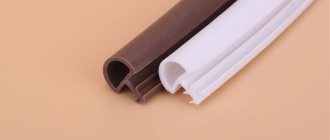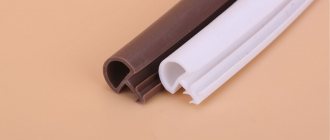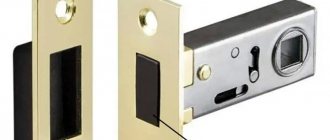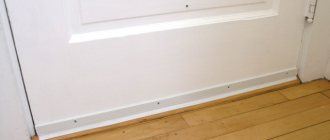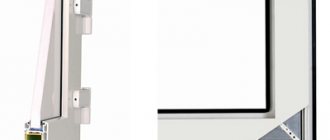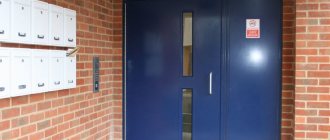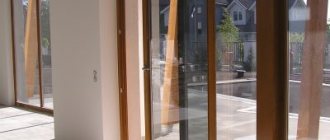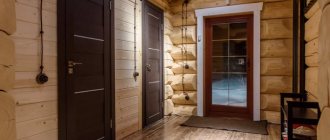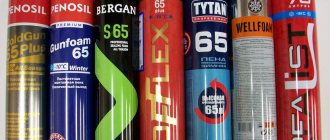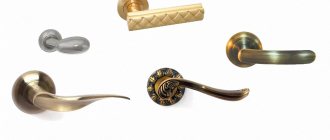SHARE ON SOCIAL NETWORKS
FacebookTwitterOkGoogle+PinterestVk
Seals for entrance doors prevent noise and cold air from entering the room from the street. This article will help you understand the existing types of products, which differ in configuration, material of manufacture, size, purpose and installation technology. Here you can find tips on how to choose the appropriate type of seal and install it correctly on the door.
Sealing tapes are used to seal doorways
Seals for entrance doors: features and advantages of use
A seal for a metal entrance door is a flexible product in the form of a small strip or tube. It is installed in the gap between the door leaf and the frame around the entire perimeter. Thanks to its easy and simple fixation, the material has a wide range of applications. It applies to pasting window frames, interior doors, compartment-type cabinets, and vents. With a high-quality seal, the front door takes on a finished look. This product eliminates a large number of shortcomings in its design.
All rubber seals differ in type and method of installation.
The material is universal because it can perform several functions simultaneously:
- protects interiors from drafts;
- prevents the penetration of dust and odors from the outside;
- ensures the tightness of the structure;
- used as door insulation;
- provides sound insulation;
- dampens the door leaf, reducing the noise level when closing.
Note! The insulation is able to compensate for minor defects in the door leaf, for example, small errors in size, bends of sheet metal, providing a more comfortable and tight closure.
Thermal Insulation Benefits of Door Gaskets
The main purpose of door seals is to eliminate gaps and cracks, preventing wind and cold air from entering the room. This is an indispensable attribute of structures in a private house facing directly onto the street.
If the door is made of wood, it will react sensitively to dampness and moisture during the rainy season. During the hot season, the material is susceptible to drying out. Under such conditions, the door frame is greatly deformed and the tightness of the door leaf is lost. You can replace the structure with a new one, but such an undertaking will cost a pretty penny. There is a budget option for solving this problem - using a seal, which can be easily and quickly replaced if necessary. It will retain heat in the room and extend the life of the door structure.
Door seals provide additional thermal insulation
As a door insulator, the gasket acts on both sides: it limits the entry of cold air from the street and retains heat from the inside. If the design does not have a seal, then the efficiency of heating devices is reduced by 40%. That's how much heat goes out. Taking into account heating prices, without installing insulation, the owner loses a large amount of money, especially in the winter months.
Soundproofing benefits of door seals
The noise-insulating properties of the products are useful if there is a construction site, a railway or highway, or a children's playground near the house. In such an environment, residents will suffer from noise due to insufficient sound insulation. The shock-absorbing properties of rubber seals for doors reduce the impact force if the door is suddenly closed due to a draft. Usually such a servant is heard not only by the residents of the house, but also by the neighbors.
In this case, the seal performs two functions at once:
- Softens the blow, absorbs unpleasant sounds.
- Extends the service life of the door structure, because strong claps contribute to rapid wear of hinges and other parts.
The shock-absorbing properties of products for metal doors are especially beneficial. These structures make a lot of noise during operation. The issue of choosing a high-quality seal with good soundproofing properties is relevant for city residents. Large cities are active both during the day and at night. In order not to suffer from city noise around the clock, it is advisable to choose products that provide enhanced sound insulation.
Sealing tape can prevent dust and noise from entering the room
Note! High-quality products can withstand temperatures ranging from -65 to 95°C. Having made the right choice, you don’t have to worry about the material cracking if it’s severely frosty or, conversely, hot outside.
Types of sealing strips for doors by configuration type
Existing types of products are classified according to different criteria. They differ in material, shape, color, size and purpose.
There are several types of configuration:
- Tape - soft products in the form of cords about 9 mm wide. The section of the tape has a rectangular shape.
- Tubular - widely used as a seal for iron doors, although the ability to seal the structure is much lower than that of strip doors.
- Groove - made in the form of soft rubber profiles, they are hollow inside. On one side of the products there is a brush, which facilitates the installation of the seal in the groove.
- Mortise - designed for door structures made of wood. Installation is carried out in a pre-cut recess in the box.
- Spring - products are installed not on the door, but directly on the frame. The area where they are installed must have a perfectly flat surface, otherwise the seal will not be able to fully perform its function.
- Folding - intended exclusively for doors with a folding leaf. These include interior structures such as a book or an accordion.
Grooved rubber seals
A rubber profile with a complex configuration is considered a universal option. It is installed on both entrance and interior structures. Available in several types of rubber with varying degrees of density. Standard width is from 8 to 10 mm.
How to choose a seal for different types of doors
When purchasing a seal, you must first take into account the type of door and where it will be used. This is important because the choice of a product with certain properties and characteristics depends on the operating conditions.
Seals can be installed on different types of doors:
- Input - predominantly a tubular version made of rubber is used. If you have a good budget, it is possible to install a magnetic door seal.
- Glass - products made of aluminum and silicone.
- Plastic - rubber types of products with a special configuration and groove type of installation.
- Interior - foam rubber products on an adhesive base and brush seals for compartment-type doors.
Important! It often happens that only one seal is suitable for a specific model of plastic door. In such cases, it will not be possible to find an analogue. Therefore, when choosing doors, you must check whether it is possible to replace the seal on the front door with products from another manufacturer. Otherwise, in case of repairs, you will have to update the entire structure.
Self-adhesive tubular seal for entrance door
Features of tape self-adhesive door seals
The simplest and most affordable product option. It is produced in the form of a self-adhesive film of different thicknesses, on top of which foam rubber is fixed. Fixation of the adhesive base depends on the type of door where the tape will be installed. Wallpaper nails are used for wood structures. If you need to install products on a metal door, the optimal solution is an adhesive with an increased safety margin, which is designed specifically for this type of material.
Foam tapes have several disadvantages. Firstly, they do not have good thermal insulation properties. Foam rubber has a porous structure. This feature of the material is clearly visible on tapes with a large width. Air passes freely through the holes in the foam, so the products can let cold currents into the room. Due to weak thermal insulation characteristics, foam rubber tapes are not recommended for use as a seal for metal doors. They are more suitable for interior structures inside residential premises.
Secondly, foam tapes are short-lived. The material is not resistant to wear, so products quickly lose their properties and become unsuitable for further use. In this case, the tape is replaced.
Characteristics of tubular rubber seals for doors
Externally, rubber products resemble a thick rope of dense material. There is a fairly large cavity inside it. Thanks to the special structure of the tubes, as well as the high strength of the rubber, the door leaf fits as tightly as possible, without forming cracks or gaps between itself and the jamb. Manufacturers use porous rubber to make tubular seals. This type of material retains heat well indoors and has increased sound insulation properties.
Tubular P-shaped seal for doors
Self-adhesive rubber seals are often found on sale. Thanks to this, the installation process of products is significantly simplified. The rubber itself is quite durable; the service life of the adhesive base is much shorter. By the time it expires, the bonding compound dries out and the material simply falls off. Despite this, the rubber seal can last for several years. After this, the product can be easily replaced with another.
Helpful advice! It is advisable to select a rubber seal for a door with an average level of hardness. If you install a product that is too soft, it will wear out very quickly. Very hard material will prevent the door from closing properly.
Magnetic seals for metal doors
Magnetic products represent a kind of frame. It completely follows the contour of the door. The frame is carefully adjusted to the design down to the millimeter. This type of sealant is considered the highest quality and most effective because it has a high strength index. For this reason, experts recommend using a magnetic seal for metal doors. The product consists of two parts. One of them is made of soft TEP material (thermoplastic elastomer), the second has the form of a magnetic insert, which ensures the attraction of the metal sheet and smooth closing without unnecessary noise.
The cost of a self-adhesive magnetic door seal is quite high. During the installation process you will need to strictly adhere to the technology. But this type of product can effectively serve for a long time, thanks to its increased resistance to wear. In addition, it provides a good level of shock absorption. When closing, the door makes no noise and seals perfectly. There are absolutely no cracks or gaps.
Magnetic seal is used for metal doors
The disadvantages of the material are related to its magnetic properties. If you incorrectly calculate the force of attraction, the door will fix too weakly or, conversely, additional physical effort will be required to open it. If you go too far with this, the child will not be able to use the door without the help of adults.
Aluminum and silicone seals for interior glass doors
Glass sealing products are produced exclusively for doors made from this material. They exactly match the dimensions of the structures for which they are intended. The profile shape of these seals is individual, the cross-section depends on the characteristics of the door leaf. To create such products, manufacturers usually use silicone. The material is quite soft and has good flexibility. Copes perfectly with the function of retaining heat. An adhesive base is not required to fix the silicone seal. To secure the product, just moisten it with water and immediately press it on the desired area of the door.
Note! Silicone, which is used to make door seals, has special properties. The moistened material sticks firmly if you hold it pressed against the glass for some time. Such good adhesion to the surface cannot be provided by conventional gaskets with an adhesive base.
Aluminum profiles are less popular. To install them, you need to additionally use door sealing rubber, which complicates the installation process and increases its cost.
Silicone rubber seals for glass doors
Silicone seals are widely used to seal doors leading into high humidity areas, such as the kitchen or bathroom. They are ideal for shower stalls with sliding or hinged glass doors. There are combined versions of products on sale - magnetic with silicone inserts.
Brush seals for interior doors
The brush seal is called a Schlegel. The product has a tape at the base with a pile attached to it. Various materials are used to make bristles:
- nylon;
- felt;
- natural bristles;
- silicone;
- metal wire;
- polyethylene.
The width and density of the bristles, as well as the colors, may vary. Their height varies over a wide range - from 3 to 15 mm. The materials used for the production of bristles are resistant to ultraviolet radiation and are characterized by chemical neutrality. The tape itself can be plastic, metal, or sometimes made of polymers. There are products both with and without an adhesive base.
Brush seals can be used for interior doors
In addition to their general functions, schlegels prevent insects from entering the room and can also be used as seals for sliding doors installed in a closet. They are also used in swing structures, when it is necessary to eliminate the gap that forms in the lower part between the sash and the floor. In this case, the seal replaces the threshold.
Related article:
Replacing a door lock: causes of breakdowns and detailed instructions for eliminating them
Common causes of lock failures. Types of castles. Replacement of cylinder, lever and crossbar devices. Replacing the larva. Advice from professionals.
For each type of door structure there is its own type of schlegel:
- Metal and wood sheets are self-adhesive seals.
- Glass sashes are products with a U-shaped profile.
- Windows and some types of doors are sealed with a groove type of installation.
Helpful advice! For sliding doors in interior doors and wardrobes, experts recommend using schlegels with short and dense bristles. It is advisable to select the colors taking into account the interior, so that the buffer tape is not too conspicuous.
Insulating a house with felt is a harsh reality
Despite all the positive aspects of this material, comprehensive insulation of a house with felt is not possible for a number of reasons:
- it absorbs moisture;
- there are moths in it;
- mice feel great in it;
- it's too expensive;
- There is no methodology for such work.
You can talk about how to insulate a door with felt from two sides:
- insulation of the box (joints);
- comprehensive insulation on the outside.
This material is also used for caulking inter-crown cracks. In addition, felt insulation for the walls of wooden houses is used as a gasket between logs (beams) during the installation of the structure. It can be used both in pure form and as part of other materials (jute). It is better to abandon attempts to completely insulate the walls of any buildings from any materials. Yes, there is strong felt for yurts that has high insulating qualities, but it still won’t work. It is not designed to be enclosed by the body of the walls, because you are not going to insulate without finishing. Felt floor insulation is used quite widely, but only as a backing for linoleum. It is not used for laminate.
Classification of sealants by texture: liquid foam rubber, flexible and pile tapes
Based on texture, flexible, liquid and pile types of products are distinguished. Each type of seal is used for specific purposes. Flexible tapes have the form of profiles with a smooth surface. Silicone and rubber are used for their production. This category also includes magnetic gaskets for door structures.
Foam rubber is the most popular material for gluing doors and windows.
Liquid options are used to insulate the fabric. The material is under pressure inside the cylinder. This version of the seal resembles the liquid equivalent of foam rubber. Pile products were among the first to appear on the market. Felt is mainly used for their production. Pile sealants are available in the form of tapes and strands. There are artificial analogues of this material made from synthetics on sale.
Features of using liquid door sealant
Liquid seals are designed to insulate metal entrance doors. The non-standard form of release requires careful handling of the material, as well as compliance with certain rules when applying it. Foam rubber in liquid form is located inside a metal container. The composition is applied to the required area of the structure by spraying. The insulation on the door hardens in a matter of seconds. Therefore, you need to act not only carefully, but also quickly. After hardening, the material significantly increases the thermal insulation qualities of the door structure.
A distinctive feature of the liquid sealant is its dislike for areas with high humidity levels. It is not recommended to use the material where there is constant dampness. Proper spraying of foam rubber requires some knowledge and good dexterity. It is advisable to practice before doing this or entrust this work to professionals, otherwise you can ruin the appearance of the door structure.
Note! Insulation materials in liquid form do not contain harmful substances. This material is not hazardous to the environment or human health, so there are no special restrictions on its use.
Sprayable liquid insulation can be used to seal doors
Characteristics of pile seals for doors
Pile sealants include felt products. You can also find synthetic analogues of this material on the market. Since felt is made from natural animal hair, it provides excellent sound and thermal insulation. Analogs of artificial origin are much inferior to it in these indicators. There are several types of felt. Taking this nuance into account, products are marked in a certain way. All types are suitable for sealing door structures. To properly install the product, you need to correctly cut the material taking into account the size of the canvas.
Advantages of natural felt:
- wear resistance;
- long service life;
- ability to withstand operation in harsh weather conditions;
- environmental cleanliness and safety;
- large margin of safety, the material retains its structure;
- high density, ideal sound absorption;
- fire safety.
In the category of artificial analogues, thin-thick pile strips, which are fixed to the surface using an adhesive base, are in particular demand among buyers. These products prevent dust from entering the living space. Artificial materials are used extremely rarely as a sealant on entrance doors. They are more suitable for compartment-type cabinets.
Pile compactors of various sizes
Where else is felt insulation used?
Felt-based linoleum - insulation and sound insulation.
In addition to the purposes described above, this material can be used for thermal insulation:
The methods, of course, are rarely used, but are still discussed on forums. Although felt for floor insulation is very often used as a backing for linoleum. When considering the hypothetical possibility of laying insulation under finishing materials, for example, insulating walls with foam plastic, you need to immediately eliminate possible problems:
- moisture – although the material does not absorb moisture well, it still happens;
- moth - you need to saturate the material with some means, but then you can forget about environmental friendliness;
- rodents will not miss the chance to steal soft bedding into their hole.
As you can see, using felt for wall insulation is quite problematic, and the price is high. It is sold by weight and costs from 200 rubles per kilo, depending on density. Such insulation will cost almost gold. Felt sealing is suitable for local thermal insulation, but even the technology has not been developed for insulating large areas. What to do in a situation where you don’t even have anyone to turn to for practical advice? You won’t find any practitioners on this issue on the forums during the day - only theorists and those are skeptical.
Types of seals for iron entrance doors: classification according to installation location
Existing products can be classified by location. Depending on the installation area, seals are:
- threshold;
- contour;
- fire protection.
Threshold varieties are not only magnetic. Most often, such seals are equipped with an automatic control system. Thanks to this, the profile can be “adjusted” to the size of the gap that forms between the floor and the door leaf. Moreover, both in the open and closed positions. These seals are used in cases where the door structure does not have a threshold to prevent the formation of drafts.
Contour products are the simplest and most common. During installation, they are fixed around the entire perimeter of the door frame or leaf. This allows you to eliminate all existing gaps and cracks. Contour options are ideal for entrance doors. In such cases, it is advisable to use products with a triple profile.
Important! Three-circuit seals are installed on fire doors. Such products significantly increase the thickness of the door leaf and its weight. For this reason, it is advisable to strengthen the box and install particularly durable fittings.
Placement of the door seal on the threshold
In rooms with a high level of fire hazard, it is advisable to use a special type of contour seal - thermally expanding. Exposure to heat or smoke triggers a chemical reaction. The material foams or expands, preventing air from entering the room. Due to lack of oxygen, the fire decreases. These products are called fireproof.
When do you need to insulate?
Wood has low thermal conductivity, but the disadvantage of the material is its response to changes in humidity and temperature. The door block dries out, swells, warps and even cracks. There are three main reasons signaling the urgent need to insulate a wooden door in a country house:
- Formation of gaps between the frame and the ends of the opening walls . Initially, during installation work, all gaps are foamed. Foam is a good insulator, but over time it loses its properties. Destruction occurs faster on the street side if platbands are not installed. Foam deteriorates from exposure to the sun. Another cause of cracks is the misalignment of the bowl.
- Formation of gaps between the frame and the sash . The most common defect in a wooden entrance door occurs due to poor wood, poor-quality installation and long-term use. Often the owner himself becomes the culprit when he trims the swollen sash so that it closes better. After drying, the product decreases in size and a gap forms.
- Wear of insulation. Each thermal insulation material is selected taking into account operational requirements. If they were not initially followed, the incorrectly selected insulation loses its effectiveness. For example, mineral wool quickly cakes, and due to dampness it decreases in volume. Any old wooden door, as well as a thin leaf, needs to be insulated.
Dimensions and shape of door seals: D-profile, P, V, E and others
The size of the seal depends on its type. The optimal parameters are selected taking into account the size of the gap. When purchasing a product, the size of the door structure is of no small importance. Taking into account its dimensions around the perimeter, the footage required to compact the canvas is calculated. For entrance doors, it is advisable to take wide products with a sufficient level of density. Flexible profiles with a rectangular cross-section are sold in rolls. The footage of the material depends on the manufacturer. Such products are designed to eliminate small gaps that do not cause serious problems during the operation of the door.
In some cases, it may be necessary to install rubber profiles with complex shapes. Such products are suitable for installation on regular and even armored doors with a heavy leaf. There is a D-shaped seal, as well as products in which the cross-section resembles other letters - E, C, O, P, etc. Each configuration is used to eliminate gaps of a certain size.
C-, E- and K-shaped profiles can cope with bridging small gaps, the width of which is no more than 3 mm. P- and V-section seals are suitable for masking gaps up to 5 mm in size. D-shaped and O-shaped seals are used much less frequently. They are designed for doors with large design errors. These products can eliminate a gap that reaches 7 mm.
Sealing rubber D-profile
If the material is soft, it is better to buy it with a reserve. Such seals fail very quickly. It is advisable to have a small supply of material on hand in order to quickly replace it if necessary. Rigid types of seals are made to fit the dimensions of the door structure. It is problematic to independently measure and calculate the required amount of material without making a mistake. It is better to seek help from specialists.
Note! To seal the door, at least 5-6 m of tape is required.
Technology for installing a door seal: how to glue and secure different types of products
In most cases, a new metal door will already have sealing material. If you don’t have one or need to replace it, you can perform the procedure for installing it yourself, adhering to certain rules.
How to glue a seal on an iron door correctly:
- high-quality door structures usually have special grooves for gluing the seal, which greatly simplifies the process;
- Preliminary surface preparation is required. It is necessary to remove dirt and dust. If the seal is replaced, the remnants of the buffer tape are removed with emery;
- the surface must be degreased. This is done with alcohol, acetone or solvent;
Installing a magnetic seal on a door
- Better sealing will be provided by multi-layer gluing. To do this, the door is sealed with sealant several times. For the structure leading to the entrance, 2 layers will be enough. If the door goes directly to the street, triple pasting will be required (inner side of the canvas - frame - outer side of the canvas);
- When using a self-adhesive seal, you need to check the expiration date of the glue on it, otherwise the product will be unsuitable for installation. It is advisable to take options where the adhesive part is mixed with small particles of fiberglass;
- if the paint on the door has been renewed, then you need to wait at least 20 days before gluing the seal;
- rubber products are attached with silicone glue. To do this, the composition is applied in a dense layer over the tape, after which it must be pressed well to the surface.
Helpful advice! When choosing products, you must pay attention to all labels, check the expiration date, type of material, and carefully study the manufacturer’s information. Only in this case the compaction result will be of high quality, and the profile itself will last quite a long time.
Mounting methods
The seal for a wooden structure can be attached in two ways: directly to the canvas or to the box. The first method involves cutting out a small niche into which the strip is attached.
The fastest and least labor-intensive installation method is to install it on an adhesive base. Self-adhesive seal for wooden doors is usually made of foam rubber and polyvinyl chloride. It is enough just to remove the protective coating from the sticky side of the product and press it to the surface of either the canvas or the box. There are models that are fastened with nails or furniture clips.
